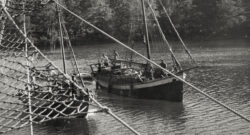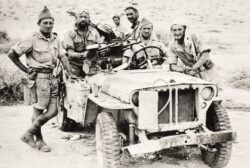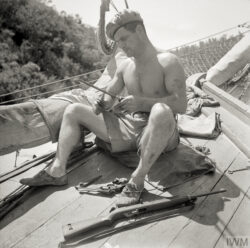Benghazi Raider: A WW2 SAS Hero’s Military Cross Medal Group

This is a rare and significant early Special Air Service Military Cross group that was awarded to Major W. J. “Bill” Cumper, Royal Engineers and 1st SAS Regiment who won the MC as a result of the famous L Detachment SAS raid on Benghazi in 1943. It was sold at auction in 2003, to an unidentified buyer, achieving a hammer price of £16,000.

William John “Bill” Cumper, an early member of ‘L’ Detachment, Special Air Service, was born in Hawick, Scotland and enlisted in the British Army as a boy soldier in January 1924. When war was declared in 1939, he was serving as a Lance-Sergeant in No. 1 Field Squadron, Royal Engineers. In May 1941 he was promoted as an Emergency Commission to the rank of Lieutenant and posted to 143 Field Park Squadron R.E. Soon he deployed to the Western Desert to join the 7th Armoured Division and was Mentioned in Despatches (MiD) in the London Gazette of 30 December 1941.
In May 1942, Cumper, a ‘tall, erect 16-stone man … who asked no quarter and gave none to his men’, was recruited to David Stirling’s still fledgling ‘L’ Detachment, Special Air Service Brigade as an explosives specialist, where he quickly established a reputation for eccentricity. John Lodwick, a fellow L Detachment member, recalls in his book Raiders from the Sea how Cumper enjoyed deflating the ego of fellow Officers. When Lodwick walked into the former enlisted man’s office for the first time, still wearing the rather garish and ostentatious uniform insignia of 12 Commando, his previous unit, Cumper shouted “My God, look out, the Commandos are here!” and dived for his captured Luger, attempting to shoot out one of the office lights.
Several SAS memoirs and histories recall similar occasions, one in particular involving a rather delicate looking Guards Officer who entered the unit’s Mess and ordered up a cup of tea. Lieutenant Cumper immediately sat down beside him, a detonator apparently tucked behind his ear, and loudly hailed a waiter with “Come ‘ere China, yer lazy rat!” And when the waiter had come, “Cup o’char, please, same as the officer”. As L Detachment medical officer, Malcolm James (Pleydell) goes on to explain in his Born of the Desert, With the S.A.S in North Africa, ‘He would step in where angels feared to tread and carry it off every time … Bill came from the ranks; he knew it, rejoiced in it, and pushed it straight in front of your face to see how you would take it.’ As it transpired, the Guards Officer took it pretty well, and he became a successful member of the unit.
When Cumper attended the six-jump parachute course, which was required training for all SAS soldiers, Cumper cut up a set of the parachute wings into six pieces and after each jump would enter the Mess with another small piece stitched onto his tunic. And the arrival of the S.A.S’s cap badge with its “Who Dares Wins” motto was simply greeted with “Oo’ cares oo’ wins?”

Left to Right – E.L.W.Francis,W.Cumper,P.Gunn,R.V.Lea
Photo by Paddy Mayne
Then there was the night an anxious but super-efficient David Stirling had harangued his gathered Officers about everything being ready for a pending operation. Afterwards looking up from his papers, he asked when the moon would rise. Cumper, having already answered in the affirmative to a string of equipment queries, mockingly apologised, “Sorry, sir, I forgot to lay that on.”
Recruited for his knowledge of explosives, Alan Hoe, a former SAS soldier (1960-80), friend and authorised biographer of SAS founder David Stirling says in his book that Stirling believed Cumper was ‘the best and most ingenious explosives man’ ‘L’ Detachment had. A ‘likeable chap,’ Stirling said, ‘he took on all the explosives training and improved our techniques tremendously.’ Another L Detachment officer, Fitzroy Maclean having also come under Cumper’s instruction wrote in Eastern Approaches,
‘Soon it became clear we had a remarkable acquisition. In addition to his knowledge of explosives, Bill had a gift for repartee which pricked anything approaching pomposity as though with a pin. He was never bad-tempered and never at a loss … Bill had become an important part of our lives.’

Bill Cumper was not just responsible for explosives training and eagerly participated in operations, being famously observed stating on the eve of one ‘activity’ as saying “Not for me mate; I’m too old. What time do we start?” These included Operation Bigamy (sometimes also incorrectly referred to as Operation Snowdrop), the raid on Benghazi in September 1942 where Cumper actually led ‘L’ Detachment to the very gates of the enemy’s Benghazi positions, for, having crawled around in the dark to investigate the surrounding mines, he went forward and unhitched the bar on the road-block, facetiously announcing, as the bar swung skyward, “Let battle commence”. It did. The words were scarcely out of his mouth when all hell broke loose. Quickly hot-footing it to Stirling’s jeep, with the faithful Reg Seekings at the wheel, amidst heavy machine-gun and mortar fire, he told the latter, undoubtedly within earshot of his CO, “If this is the bloody SAS you can keep it, you crazy bastard.” In fact, transport that night became a serious problem, the three leading jeeps quickly being marked by the enemy’s fire.
Cumper eventually alighted upon another, the driver, Sgt Bob Bennett receiving a broadside when he was unceremoniously ejected from the back as recounted in Philip Warner’s book, The Special Air Service,
‘(Cumper) leapt on to the one driven by Sergeant Bennet (sic); his hold was not very secure and after a while he fell off. Bennet stopped the jeep and ran back. Cumper was lying in the middle of the road, head supported on arm as if on a vicarage lawn. All around was an inferno of fire and explosion. As Bennet came up – to find Cumper unhurt – Cumper said: ‘Now, look here Bennet, if that’s the way you treat your passengers I’m going to stay here and have a nice quiet read until you’ve learnt to drive properly.’

They made it back safely and it was for the Benghazi raid that Cumper received his Military Cross (MC) which was gazetted on 14 October 1943. The recommendation for the award states,
‘On 14 September 1942, the 1st S.A.S. Regiment raided Benghazi. From information received on the previous day it was believed that the Benghazi garrison had fortified their position by mines, wire and other entanglements. These obstructions to a night raiding party without artillery or tanks might have proved disastrous. Captain Cumper volunteered to lift the mines and clear a way through the entanglements and so lead the raiding party in. He picked a way which avoided mines and got the party to within thirty yards of the enemy’s positions. He carried on and managed to open the gate which allowed the attacking force to get at the enemy. All through the operation, Captain Cumper’s cheerfulness and bravery had a magnificent effect on the morale of the troops, and, although faced with an extremely dangerous and difficult job, he showed no regard for his own safety.’
In September 1943, Cumper was transferred to HQ Raiding Forces with whom he served until September of the following year, an appointment that witnessed further clandestine operations with the Special Raiding Squadron (SRS), 2 SAS and Special Boat Squadron (SBS). According to Richard Capell’s 1946 book, Simiomata: A Greek Note Book 1944-45, Cumper participated in no less than 30 operations during this time. Among them was the raid conducted by the SBS and Greek Sacred Squadron on the island of Symi (Operation Tenement) in July 1944. John Lodwick recalls how Cumper set about assorted demolition work once the German garrison had been brought to heel:
‘General demolitions were begun by Bill Cumper and installations as varied as 75mm gun emplacements, diesel fuel pumps and cable-heads, received generous charges. Ammunition and explosive dumps provided fireworks to suit the occasion. In the harbour, nineteen German caiques, some displacing as much as 150 tons, were sunk. At midnight the whole force sailed, the prisoners being crowded into two ‘Ems’ barges …’


Bill Cumper returned to the SAS between August 1945 and January 1946, prior to returning to regular duties with the Royal Engineers and was finally discharged from military service in December 1948 with the honorary rank of Major, having been awarded his Long Service & Good Conduct medal (L.S. & G.C.) the previous March. He moved to Rhodesia with his wife and died tragically after a stay in a prison hospital in December 1954. He had suffered a stroke, been paralysed and unable to speak, but had been turned away from the Salisbury General Hospital because his admission papers were signed for a hospital 300 miles away. Critically ill, with his Greek born wife not allowed to nurse him at home, he was sent to the Salisbury Gaol where he was locked up in the prison hospital without attendants other than the guard. He died shortly after his release. He left behind a widow and son, the latter’s godfather being David Stirling.
Bill Cumper’s medal group is another significant special forces medal group that has been sold by the auction house, Dix Noonan Web. The lot included his Military Cross, G.VI.R. reverse officially dated ‘1943’ and additionally inscribed ‘Major W. J. Cumper, R.E.); 1939-45 Star; Africa Star, clasp, 8th Army; Italy Star; Defence and War Medals, with M.I.D. oak leaf; General Service 1918-62, 1 clasp, Palestine 1945-48 (Major W. J. Crumper (M.C.) R.E.) note spelling of surname; Regular Army L.S. & G.C., G.VI.R., 1st issue (2.Lieut. W. J. Cumper, (M.C.) R.E.) this with official corrections, together with Greek commemorative Campaign Star 1941-45 (Land Operations), officers’ bullion SAS wings, Free French wings, cloth cap badge and ‘1st S.A.S.’ shoulder title, Greek Sacred Squadron bronze badge, cloth and bullion Greek Service badge, 1st pattern SAS Association enamelled badge, this numbered ‘538’, and similar tie-pin Also included was a quantity of original documentation, including M.I.D. Certificate dated 30 December 1941 (Lieutenant, Royal Engineers), War Office forwarding letter for M.C., named certificate for Greek Sacred Squadron badge, various official wartime ‘flimsies’ concerning his M.I.D., registration of marriage (Lieut. W. J. Cumper, “L” Det. S.A.S. Bde, Combined Training Centre, 22 Aug. 1942) and a Movement Order, official copy recommendation for M.C., several original photographs and news cuttings.


____________________________________________________
Related Post – ‘L’ Detachment SAS ‘original’ Fred Casey’s Memorabilia and Archive










